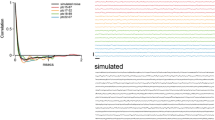Abstract
The multichannel recordings of signals of many cells cultivated on a multielectrode array (MEA) impose some challenging problems. A meanwhile classic problem is the separation of the recordings of a single electrode into classes of recordings where each class is caused by a single cell. This is the well-known spike sorting. A “dual” problem is the determination of the set of electrodes that record signals of a single cell. This set is called the neighborhood of the cell and has often more than one element if the MEA has a large number of electrodes with high density. A method for the reconstruction of the neighborhoods from the multichannel recordings is presented. Special effort is directed to a precise peak detection. For the evaluation of the algorithm, artificial data, obtained from an appropriate model of MEA recordings, are used. Because the artificial data provide a ground truth, an evaluation of the accuracy of the algorithm is possible. The algorithm works well for realistic parameters.




Similar content being viewed by others
References
Blanche, T.J., Spacek, M.A., Hetke, J.F., Nicholas, V.S. (2005). Polytrodes: High-density silicon electrode arrays for large-scale multiunit recording. Journal of Neurophysiology, 93(5), 2987–3000.
Brown, G.D., Yamada, S., Sejnowski, T.J. (2001). Independent component analysis at the neural cocktail party. Trends in Neurosciences, 24(1), 54–63.
Einevoll, G.T., Franke, F., Hagen, E., Pouzat, C., Harris, K.D. (2012). Towards reliable spike-train recordings from thousands of neurons with multielectrodes. Current Opinion in Neurobiology, 22(1), 11–17.
Franke, F., Natora, M., Boucsein, C., Munk, M.H.J., Obermayer, K. (2010). An online spike detection and spike classification algorithm capable of instantaneous resolution of overlapping spikes. Journal of Computational Neuroscience, 29(1–2), 127– 148.
Gibson, S., Judy, J.W., Marković, D. (2012). Spike sorting: The first step in decoding the brain. Signal Processing Magazine, IEEE, 29(1), 124–143.
Jäckel, D., Frey, U., Fiscella, M., Franke, F., Hierlemann, A. (2012). Applicability of independent component analysis on high-density microelectrode array recordings. Journal of Neurophysiology, 108(1), 334–348.
Letelier, J.C., & Weber, P.P. (2000). Spike sorting based on discrete wavelet transform coefficients. Journal of Neuroscience Methods, 101, 93–106.
Lewicki, M.S. (1998). A review of methods for spike sorting: the detection and classification of neural action potentials. Network: Computation in Neural Systems, 9(4), R53—R78.
Mamlouk, A.M., Sharp, H., Menne, K.M.L., Hofmann, U.G., Martinetz, T. (2005). Unsupervised spike sorting with ICA and its evaluation using GENESIS simulations. Neurocomputing, 0, 275–282.
Pedreira, C., Martinez, J., Ison, M.J., Quiroga, R.Q. (2012). How many neurons can we see with current spike sorting algorithms. Journal of Neuroscience Methods, 211, 58–65.
Quiroga, R.Q., Nadasdy, Z., Ben-Shaul, Y. (2004). Unsupervised spike detection and sorting with wavelets and superparamagnetic clustering. Neural Computation, 16, 1661–1687.
Takahashi, S., Anzai, Y., Sakurai, Y. (2003). Automatic sorting for multi-neuronal activity recorded with tetrodes in the presence of overlapping spikes. Journal of Neurophysiology, 89(4), 2245–2258.
Segev, R., Goodhouse, J., Puchalla, J., Berry II, M.J. (2004). Recording spikes from a large fraction of the ganglion cells in a retinal patch. Nature Neuroscience, 7(10), 1155–1162.
Prentice, J.S., Homann, J., Simmons, K.D., Tkačik, G, Balasubramanian, V., Nelson, P.C. (2011). Fast, Scalable, Bayesian Spike Identification for Multi-Electrode Arrays. PLoS ONE, 6(7), e19884.
Olivier, M., Amodei, D., Deshmukh, N., Sadeghi, K., Soo, F., Holy, T.E., Berry II, M.J. (2012). Mapping a complete neural population in the retina. The Journal of Neuroscience, 32(43), 14859– 14873.
Pillow, J.W., Shlens, J., Chichilnisky, E.J., Simoncelli, E.P. (2013). A Model-Based Spike Sorting Algorithm for Removing Correlation Artifacts in Multi-Neuron Recordings. PLoS ONE, 8(5), e62123.
Acknowledgements
We are grateful for the financial support of the Deutsche Forschungsgemeinschaft for the DFG graduate school 1505/2 welisa. We are also thankful for the fruitful discussions with the department of biophysics, especially with Jan Gimsa, Werner Baumann, Tom Reimer and Matthias Nissen. Last but not least we thank two anonymous reviewers whose careful readings, helpful comments and suggestions contribute to amend this paper.
Conflict of interest
The authors declare that they have no conflict of interest.
Author information
Authors and Affiliations
Corresponding author
Additional information
Action Editor: Tim Gollisch
Electronic supplementary material
Below is the link to the electronic supplementary material.
Rights and permissions
About this article
Cite this article
Engel, K., Hanisch, S. Reconstruction of cell-electrode-adjacencies on multielectrode arrays. J Comput Neurosci 37, 583–591 (2014). https://doi.org/10.1007/s10827-014-0524-6
Received:
Revised:
Accepted:
Published:
Issue Date:
DOI: https://doi.org/10.1007/s10827-014-0524-6




